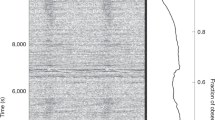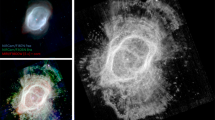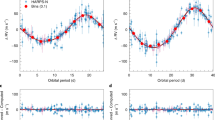Abstract
The ‘characteristic age’1 of a pulsar is usually considered to approximate its true age, but this assumption has led to some puzzling results, including the fact that many pulsars with small characteristic ages have no associated supernova remnants2,3. The pulsar B1757-24 is located just outside the edge of a supernova remnant4,5,6; the properties of the system indicate that the pulsar was born at the centre of the remnant with a substantial velocity, and that it has subsequently overtaken the expanding blast wave5,6,7,8. With a characteristic age of 16,000 yr, the pulsar is expected8 to have a proper motion of 63–80 milliarcseconds (mas) per year. Here we report observations of the nebula surrounding the pulsar, which limit its proper motion to less than 25 mas yr-1, implying a minimum age of 39,000 yr. A more detailed analysis argues that the true age may be as great as 170,000 yr, which is significantly larger than the characteristic age. We conclude from this result and other discrepancies associated with pulsars that characteristic ages greatly underestimate the true ages of pulsars.
This is a preview of subscription content, access via your institution
Access options
Subscribe to this journal
Receive 51 print issues and online access
$199.00 per year
only $3.90 per issue
Buy this article
- Purchase on Springer Link
- Instant access to full article PDF
Prices may be subject to local taxes which are calculated during checkout


Similar content being viewed by others
References
Manchester, R. N. & Taylor, J. H. Pulsars (Freeman, San Francisco, 1977).
Braun, R., Goss, W. M. & Lyne, A. G. Three fields containing young pulsars: The observable lifetime of supernova remnants. Astrophys. J. 340, 355–361 (1989).
Stappers, B. W., Gaensler, B. M. & Johnston, S. A deep search for pulsar wind nebulae using pulsar grating. Mon. Not. R. Astron. Soc. 308, 609– 617 (1999).
Manchester, R. N., D'Amico, N. & Tuohy, I. R. A search for short period pulsars. Mon. Not. R. Astron. Soc. 212, 975–986 (1985).
Manchester, R. N., Kaspi, V. M., Johnston, S., Lyne, A. G. & D'Amico, N. A remarkable pulsar-supernova remnant association. Mon. Not. R. Astron. Soc. 253, 7P–10P (1991).
Frail, D. A. & Kulkarni, S. R. Unusual interaction of the high-velocity pulsar PSR 1757-24 with the supernova remnant G5.4-1.2. Nature 352, 785–787 ( 1991).
Shull, J. M., Fesen, R. A. & Saken, J. M. Pulsar reenergization of old supernova remnant shells. Astrophys. J. 346, 860– 868 (1989).
Frail, D. A., Kassim, N. E. & Weiler, K. W. Radio imaging of two supernova remnants containing pulsars. Astron. J. 107, 1120– 1127 (1994).
Becker, R. H. & Helfand, D. J. A new class of nonthermal radio sources. Nature 313, 115– 118 (1985).
Caswell, J. L. et al. The Galactic radio sources G5.4-1.2 and G5.27-0.90. Mon. Not. R. Astron. Soc. 225, 329– 334 (1987).
Lyne, A. G. & Lorimer, D. R. High birth velocities of radio pulsars. Nature 369, 127– 129 (1994).
Cordes, J. M. & Chernoff, D. F. Neutron star population dynamics. II. Three-dimensional space velocities of young pulsars. Astrophys. J. 505, 315–338 ( 1998).
van Buren, D. & McCray, R. Bow shocks and bubbles are seen around hot stars by IRAS. Astrophys. J. 329, L93 –L96 (1988).
Frail, D. A. & Scharringhausen, B. R. A radio survey for pulsar wind nebulae. Astrophys. J. 480, 364– 370 (1997).
Thompson, D. J. et al. EGRET high-energy gamma-ray pulsar studies. I. Young spin-powered pulsars. Astrophys. J. 436, 229– 238 (1994).
Gaensler, B. M. & Johnston, S. The pulsar/supernova remnant connection. Mon. Not. R. Astron. Soc. 277, 1243–1253 (1995).
Cioffi, D. F., McKee, C. F. & Bertschinger, E. Dynamics of radiative supernova remnants. Astrophys. J. 334, 252–265 (1988).
Lyne, A. G., Pritchard, R. S. & Smith, F. G. Crab pulsar timing 1982–1987. Mon. Not. R. Astron. Soc. 233, 667–676 (1988).
Kaspi, V. M., Manchester, R. N., Siegman, B., Johnson, S. & Lyne, A. G. On the spin-down of PSR B1509-58. Astrophys. J. 422, L83– L86 (1994).
Lyne, A. G., Pritchard, R. S., Graham-Smith, F. & Camilo, F. Very low braking index for the Vela pulsar. Nature 381, 497–498 (1996).
Lyne, A. G. et al. A giant glitch in PSR B1757-24. Mon. Not. R. Astron. Soc. 281, L14–L16 ( 1996).
Blandford, R. D., Applegate, J. H. & Hernquist, L. Thermal origin of neutron star magnetic fields. Mon. Not. R. Astron. Soc. 204, 1025– 1048 (1983).
Blandford, R. D. & Romani, R. W. On the interpretation of pulsar braking indices. Mon. Not. R. Astron. Soc. 234, 57P–60P (1988).
Seward, F. D., Harnden, F. R. Jr, Murdin, P. & Clark, D. H. MSH 15-52: A supernova remnant containing two compact X-ray sources. Astrophys. J. 267, 698–710 (1983).
Frail, D. A., Goss, W. M. & Whiteoak, J. B. Z. The radio lifetime of supernova remnants and the distribution of pulsar velocities at birth. Astrophys. J. 437, 781–793 (1994).
Brazier, K. T. S. & Johnston, S. The implications of radio-quiet neutron stars. Mon. Not. R. Astron. Soc. 305, 671–679 (1999).
Umeda, H., Shibazaki, N., Nomoto, K. & Tsuruta, S. Thermal evolution of neutron stars with internal frictional heating. Astrophys. J. 408, 186–193 (1993).
Sault, R. J. & Killeen, N. E. B. The Miriad User's Guide (Australia Telescope National Facility, Sydney, 1998); also at 〈http://www.atnf.csiro.au/computing/software/miriad〉.
Keys, R. G. Cubic convolution interpolation for digital image processing. IEEE Trans. Acoustic Speech Signal Process 29, 1151 –1160 (1981).
Powell, M. J. D. A method for minimizing a sum of squares of non-linear functions without calculating derivatives. Comput. J. 7, 303– 307 (1964).
Acknowledgements
We thank V. Kaspi and D. Chakrabarty for useful discussions, N. Kassim for supplying 90-cm data on G5.4-1.2 and A. Lyne for providing timing data on PSR B1757-24. The National Radio Astronomy Observatory is a facility of the National Science Foundation operated under cooperative agreement by Associated Universities, Inc. B.M.G. acknowledges the support of NASA through a Hubble Fellowship awarded by the Space Telescope Science Institute.
Author information
Authors and Affiliations
Corresponding author
Rights and permissions
About this article
Cite this article
Gaensler, B., Frail, D. A large age for the pulsar B1757-24 from an upper limit on its proper motion. Nature 406, 158–160 (2000). https://doi.org/10.1038/35018010
Received:
Accepted:
Issue Date:
DOI: https://doi.org/10.1038/35018010
This article is cited by
-
Some stars may be older than they look
Nature (2000)
-
Older than they look
Nature (2000)
Comments
By submitting a comment you agree to abide by our Terms and Community Guidelines. If you find something abusive or that does not comply with our terms or guidelines please flag it as inappropriate.



